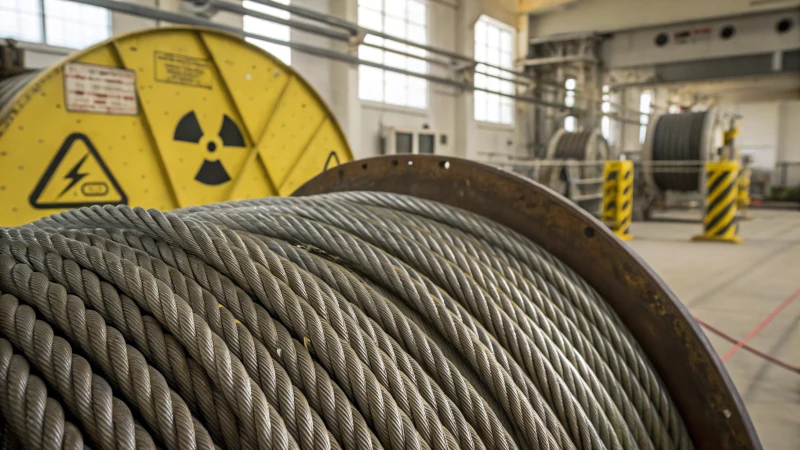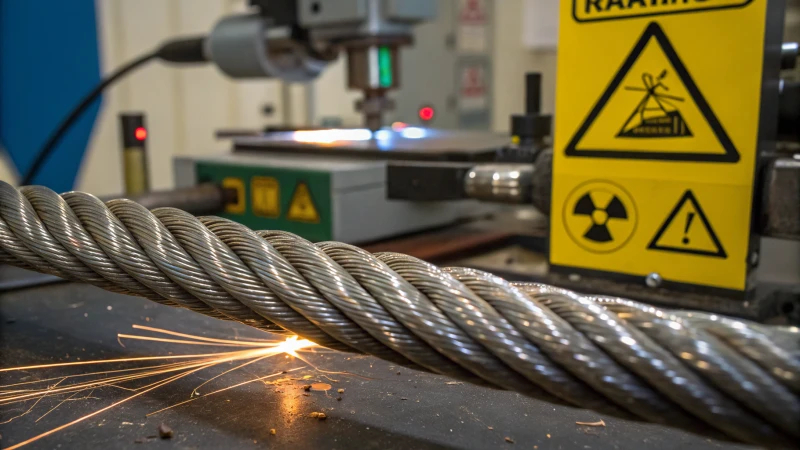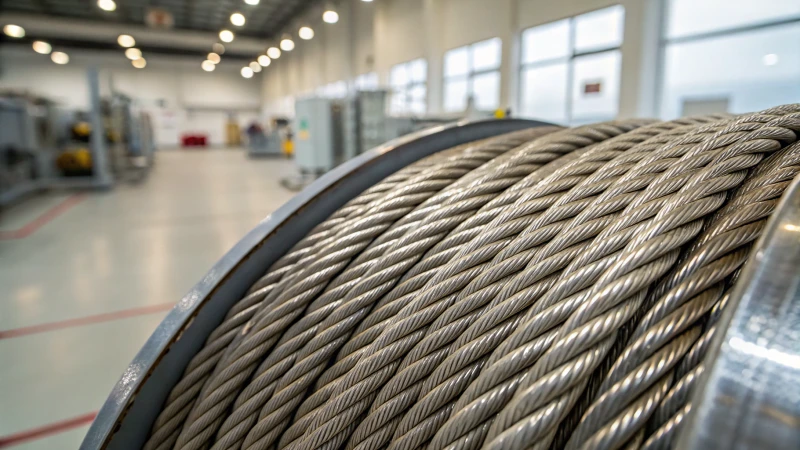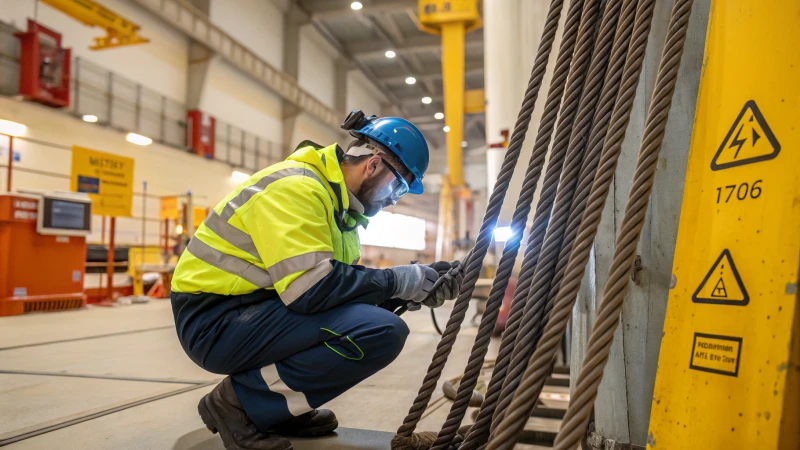
I remember the first time I visited a nuclear power plant, the sheer complexity and precision of every component left me in awe.
Steel wire ropes can undergo significant degradation when exposed to high radiation levels in nuclear power plants. Radiation may cause embrittlement and reduce tensile strength, particularly in carbon steels. However, using stainless steels and specialized coatings can enhance resistance and extend their lifespan.
Thinking back, I recall the meticulous attention to detail required in such environments, especially regarding materials like steel wire ropes that are crucial for safety. While my initial understanding was basic, diving deeper into alloy compositions and coating techniques revealed just how much effort goes into ensuring these materials can handle radiation's harsh effects. It’s fascinating to see how different alloys, like stainless steel, are crafted with higher chromium content to better resist radiation, protecting both the integrity of the wire ropes and the safety of the plant operations. It’s a testament to human ingenuity in overcoming such challenges.
Steel wire ropes degrade in nuclear plant radiation.True
Radiation causes embrittlement and reduced tensile strength in steel.
Stainless steel ropes resist radiation better than carbon steel.True
Stainless steels with coatings show enhanced radiation resistance.
How Does Radiation Affect Steel Wire Ropes?
Imagine working in an environment where radiation subtly but surely alters the very tools meant to ensure safety.
Radiation can severely impact steel wire ropes by causing embrittlement and reducing tensile strength, leading to potential failures. Stainless steels, with their higher chromium content, offer better resistance compared to carbon steels, making them more suitable for high-radiation environments.

Radiation-Induced Material Changes
I remember the first time I walked into a nuclear facility, the sheer magnitude of radiation's power struck me. It’s not just about what you see; it’s the invisible threat that can turn a solid steel wire rope into a brittle liability. Exposure to ionizing radiation, such as gamma rays and neutron radiation, alters the microstructure of steel wire ropes. This leads to embrittlement—a process where the metal becomes less flexible, significantly compromising its mechanical properties like tensile strength.
A fascinating study on radiation impact1 highlighted that carbon steel ropes could lose 30-40% of their tensile strength after a decade of exposure typical in nuclear facilities. It’s unnerving to think that something so strong can become weak under stress due to radiation-induced changes.
Comparative Resistance of Steel Alloys
When choosing materials, I’ve learned that not all steels are created equal. The alloy composition is crucial. Standard carbon steels tend to degrade much faster than stainless steels like AISI 304 or AISI 316. The secret sauce? It’s the chromium content in stainless steels that offers superior radiation resistance, preserving their structure over time.
| Steel Type | Radiation Resistance |
|---|---|
| Carbon Steel | Low |
| Stainless Steel (AISI 304/316) | High |
Specialized alloys or coatings can enhance resistance even further. If you’re in procurement, understanding these differences is key to selecting the right material for high-radiation environments.
Role of Coatings and Surface Treatments
It’s tempting to think a coating might be the magic fix, but in reality, coatings like polyurethane and polyethylene have their limits. They offer some protection but need frequent inspections and replacements in high-radiation zones.
For example, ropes with coatings in radiation-prone areas may last 5-7 years before needing replacement, whereas uncoated ropes can degrade significantly within 2-3 years. This underscores the importance of regular non-destructive testing2 to assess the ropes’ internal conditions.
Monitoring and Maintenance Considerations
Preventing accidents in radiation-heavy areas means staying vigilant. Implementing strict monitoring protocols is crucial. Non-destructive testing methods like ultrasonic testing are invaluable for assessing internal damage over time.
For procurement officers and engineers, establishing routine testing and maintenance schedules is vital to maintain safety and performance standards in radiation environments.
Understanding these nuances empowers industry professionals to make informed decisions about sourcing and maintaining steel wire ropes for use in potentially hazardous conditions. Learn more about safe procurement practices3.
Stainless steel ropes resist radiation better than carbon steel.True
Stainless steels like AISI 304/316 have higher chromium content, enhancing resistance.
Coated ropes in radiation areas last 10 years without replacement.False
Coated ropes need replacing every 5-7 years in high-radiation areas.
How Do Alloy Compositions Affect Radiation Resistance?
Ever wondered how the metals we choose can stand up to the harshest environments? It's a fascinating blend of science and art.
Alloy compositions influence radiation resistance by modifying a material's microstructure. Elements like chromium in stainless steel bolster resistance by preserving integrity under radiation, while carbon steels deteriorate more quickly. Fine-tuning these compositions enhances durability in radiation-rich settings.

The Role of Alloying Elements
I remember the first time I truly grasped the magic of alloy compositions. It was during a project where we had to select materials for a facility exposed to high radiation levels. At first, it felt like deciphering a complex puzzle. I learned that elements like chromium4 in stainless steels, such as AISI 304 and AISI 316, significantly boost their radiation resilience. Chromium works wonders by maintaining the steel's microstructural integrity, making it less prone to becoming brittle or degrading compared to standard carbon steels.
| Alloy Type | Key Elements | Radiation Resistance |
|---|---|---|
| Standard Carbon | Carbon | Low |
| Stainless Steel | Chromium | High |
| Specialized Alloys | Tungsten | Very High |
Microstructural Changes Under Radiation
When materials are exposed to ionizing radiation, they undergo microstructural changes that can weaken their mechanical properties. I recall a case where a colleague mentioned how standard carbon steels became noticeably more brittle and lost tensile strength over time. In contrast, alloys with high chromium content showed remarkable resilience because they could form stable oxide layers that fend off radiation-induced defects.
Enhancing Radiation Resistance with Coatings
Beyond alloying elements, I've found that surface treatments like tungsten-based coatings5 can further enhance a material's resistance to radiation. These coatings act as additional shields against radiation damage, though their effectiveness does have limits in extreme environments. Regular inspections and timely replacements are key to maintaining safety.
Practical Applications
Gaining insight into how alloy compositions affect radiation resistance is crucial for industries like nuclear power and aerospace, where materials face intense radiation. Engineers, much like myself on that initial project, can optimize material properties by choosing suitable alloys, ensuring greater durability and safety in high-radiation environments. In nuclear power plants, for example, using stainless steel with high chromium content can significantly prolong the lifespan of structural components, slashing the need for frequent replacements and maintenance.
For further exploration on material choices in nuclear environments, you may want to consult detailed studies about specific alloy compositions6 and their performance under radiation exposure.
Chromium enhances radiation resistance in stainless steel.True
Chromium maintains microstructural integrity, reducing embrittlement.
Standard carbon steels have high radiation resistance.False
They experience increased brittleness and reduced tensile strength.
How Can Coatings Improve Steel Wire Rope Durability in Radiation?
Ever wondered if a simple coating could be the superhero that saves steel wire ropes from radiation's wrath?
Coatings can indeed enhance the durability of steel wire ropes in radiation-prone environments by acting as a protective shield against degradation. While materials like polyurethane provide basic protection, more specialized coatings such as tungsten-based ones offer superior resistance, particularly in high-radiation settings.

Understanding Radiation Effects on Steel Wire Ropes
I remember my first encounter with the concept of radiation impacting materials. It was during a project where the team struggled to understand why equipment failed prematurely. We discovered that radiation, especially the ionizing types like gamma rays, can wreak havoc on steel, altering its very microstructure and making it brittle. In high-radiation environments7, this brittleness means steel wire ropes can lose their tensile strength and, ultimately, their longevity.
Exploring Coating Materials
When I first learned about coatings, I thought they were just about aesthetics or preventing rust. However, in environments heavy with radiation, coatings like tungsten-based layers become vital warriors. While polyurethane and polyethylene coatings are commonly used for general protection, their efficacy diminishes under intense radiation. That's why, in places like nuclear plants, tungsten-based coatings are the go-to.
| Coating Material | Radiation Resistance | Application |
|---|---|---|
| Polyurethane | Low | General use |
| Tungsten-based | High | Nuclear plants |
Evaluating Performance and Cost
Balancing cost and performance is something I’ve often debated with colleagues. Polyurethane coatings8 might be budget-friendly, but in radiation zones, frequent replacements add up. On the flip side, while tungsten coatings are pricier, they promise longevity, making them a wise investment for projects where durability is non-negotiable.
The Role of Alloy Composition
From my experience, the type of steel alloy used can make or break the effectiveness of a coating. Stainless steels like AISI 304 and 316 seem to have a natural edge over others due to their chromium content, which inherently fights off radiation-induced damage. Pairing the right alloy with a robust coating can be a game-changer in maximizing durability.
For those curious about alloy properties, delving into stainless steel alloys9 commonly used in such applications can be enlightening.
Monitoring and Maintenance
Even with top-notch coatings, regular check-ups using methods like ultrasonic testing are crucial. It's a bit like getting a health check-up to catch any early signs of trouble. This proactive approach can save time, money, and ensure safety by catching issues before they escalate.
For more on testing techniques, resources on ultrasonic testing methods10 might be helpful.
Tungsten coatings resist radiation better than polyurethane.True
Tungsten-based coatings have higher radiation resistance, ideal for nuclear settings.
Polyurethane is more cost-effective than tungsten-based coatings.True
Polyurethane is cheaper but less durable in high-radiation environments.
How Can We Ensure Steel Rope Reliability in Nuclear Plants?
When it comes to the safety of nuclear plants, steel ropes quietly play a heroic role. Keeping them in top shape is non-negotiable, and that's where rigorous testing methods step in.
Non-destructive testing (NDT) methods, like magnetic flux leakage and ultrasonic testing, are crucial for ensuring steel rope reliability in nuclear plants. These techniques detect defects without damaging the ropes, ensuring both safety and longevity.

Non-Destructive Testing Methods
In my experience with steel ropes11 in high-stakes environments, non-destructive testing (NDT) feels like magic. It’s like having a superpower that lets you see inside these ropes without cutting them open. Techniques like magnetic flux leakage (MFL) and ultrasonic testing are lifesavers. They help us spot potential flaws without any damage, ensuring everything runs smoothly.
Magnetic Flux Leakage (MFL)
I remember the first time I saw MFL in action—it was like watching a detective at work. By magnetizing the rope and using sensors to pick up anomalies in the magnetic field, we can pinpoint issues like broken wires or corrosion, even if they’re just under the surface. In environments where every detail matters, this method shines.
| Advantages | Limitations |
|---|---|
| Detects corrosion | Limited to surface flaws |
| Non-invasive | Requires specialized equipment |
Ultrasonic Testing
Ultrasonic testing, on the other hand, uses sound waves to reveal what’s happening inside the rope. I find it fascinating how sound can travel through the material and alert us to any disruptions indicating defects. This method is particularly sensitive, making it invaluable for checking the internal health of the ropes.
- Pros: Accurate, detects both surface and internal flaws.
- Cons: Requires skilled technicians for accurate interpretation.
Visual Inspection Techniques
Even with all these high-tech methods, there's nothing quite like the good old-fashioned visual inspection. It’s like when you’re looking for wear and tear on your favorite pair of shoes; sometimes, a keen eye can catch what technology might miss. Regular checks for visible wear, corrosion, or fraying are crucial in preventing unexpected failures12, especially in nuclear settings where safety is paramount.
Compliance with Industry Standards
Keeping up with industry standards feels like keeping up with a good friend—essential for maintaining a strong relationship with safety and efficiency. By following guidelines from organizations like OSHA or ISO, we ensure that our steel ropes not only meet but exceed expectations for safety compliance13.
| Standard | Description |
|---|---|
| OSHA 1910.184 | Covers general industry lifting standards |
| ISO 4309 | Focuses on crane wire rope maintenance |
Regular updates and adherence to these standards are not just about ticking boxes; they’re about making sure that we’re always a step ahead in ensuring safety and efficiency.
MFL can detect internal flaws in steel ropes.False
MFL is effective for surface and near-surface defects, not internal.
Ultrasonic testing requires skilled technicians.True
Accurate interpretation of ultrasonic data needs skilled technicians.
Conclusion
Steel wire ropes in nuclear power plants face radiation-induced degradation, with stainless steels offering better resistance than carbon steels. Regular inspections and specialized coatings enhance durability and safety.
-
Provides detailed research findings on how radiation affects tensile strength and structural integrity. ↩
-
Describes various non-destructive testing methods that help assess the internal condition of wire ropes. ↩
-
Offers guidance on sourcing materials suitable for high-radiation environments. ↩
-
This link explains how chromium enhances the radiation resistance of stainless steel, crucial for structural integrity. ↩
-
Explore the benefits of tungsten coatings in improving material resilience to radiation. ↩
-
Discover detailed studies on alloys optimized for high-radiation settings. ↩
-
Understanding radiation effects helps in choosing appropriate materials for high-radiation environments. ↩
-
Learn about polyurethane's protective capabilities and limitations. ↩
-
Explores alloy properties beneficial for radiation resistance. ↩
-
Provides insights into detecting damage early through testing. ↩
-
Learn how non-destructive testing methods can enhance the reliability of steel ropes in critical applications. ↩
-
Understand the role of regular visual inspections in preventing unexpected rope failures. ↩
-
Discover OSHA's guidelines for ensuring wire rope safety in industrial settings. ↩

